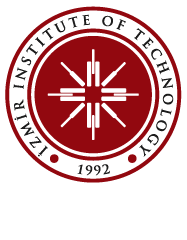Papers in 2024
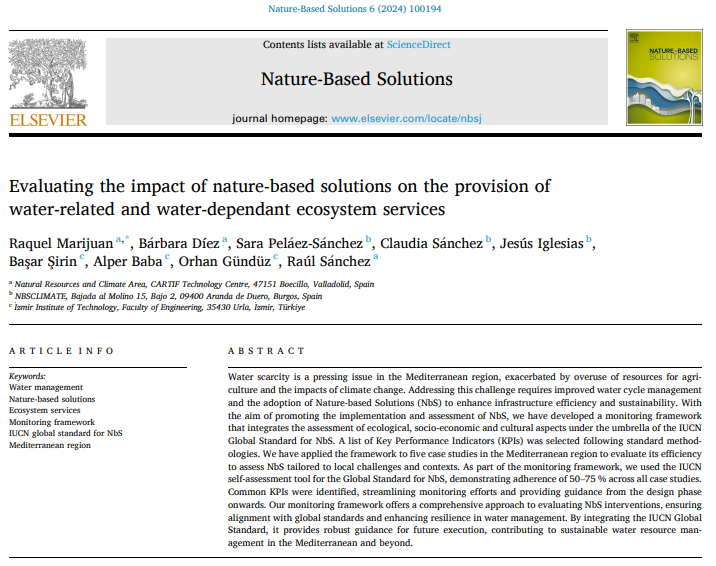
Evaluating the impact of nature-based solutions on the provision of
water-related and water-dependant ecosystem services
Water scarcity is a pressing issue in the Mediterranean region, exacerbated by overuse of resources for agriculture and the impacts of climate change. Addressing this challenge requires improved water cycle management and the adoption of Nature-based Solutions (NbS) to enhance infrastructure efficiency and sustainability. With the aim of promoting the implementation and assessment of NbS, we have developed a monitoring framework that integrates the assessment of ecological, socio-economic and cultural aspects under the umbrella of the IUCN Global Standard for NbS. A list of Key Performance Indicators (KPIs) was selected following standard methodologies. We have applied the framework to five case studies in the Mediterranean region to evaluate its efficiency to assess NbS tailored to local challenges and contexts. As part of the monitoring framework, we used the IUCN self-assessment tool for the Global Standard for NbS, demonstrating adherence of 50–75 % across all case studies. Common KPIs were identified, streamlining monitoring efforts and providing guidance from the design phase onwards. Our monitoring framework offers a comprehensive approach to evaluating NbS interventions, ensuring alignment with global standards and enhancing resilience in water management. By integrating the IUCN Global Standard, it provides robust guidance for future execution, contributing to sustainable water resource management in the Mediterranean and beyond
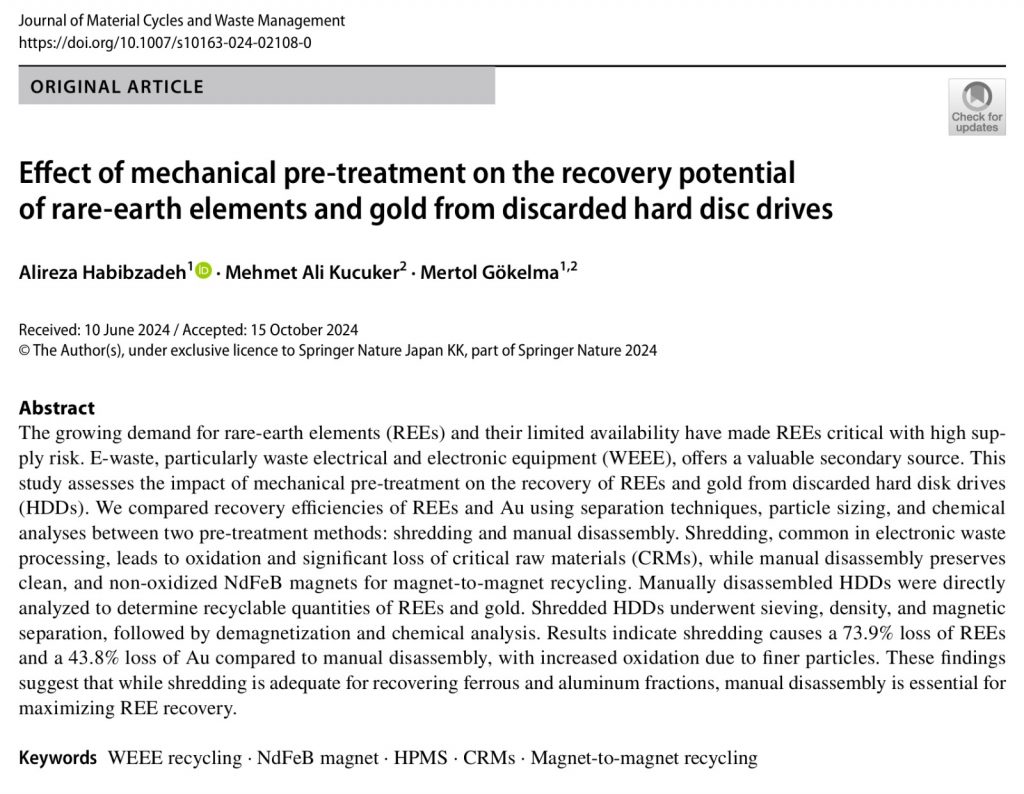
Effect of mechanical pre-treatment on the recovery potential of rare-earth elements and gold from discarded hard disc drives
The article titled “Effect of Mechanical Pre-treatment on the Recovery Potential of Rare-Earth Elements and Gold from Discarded Hard Disk Drives,” co-authored by our faculty member Dr.-Ing. Mehmet Ali Küçüker, has been published in the Journal of Material Cycles and Waste Management.
As global demand for Rare Earth Elements (REEs) surges, the supply risk associated with these vital resources becomes ever more pressing. E-waste, particularly from Waste Electrical and Electronic Equipment (WEEE), provides a valuable secondary source for recovering REEs and gold. However, the recovery method significantly impacts success rates and material purity. This research examines the impact of two mechanical pre-treatment methods—shredding and manual disassembly—on recovering REEs and gold from discarded hard disk drives (HDDs).
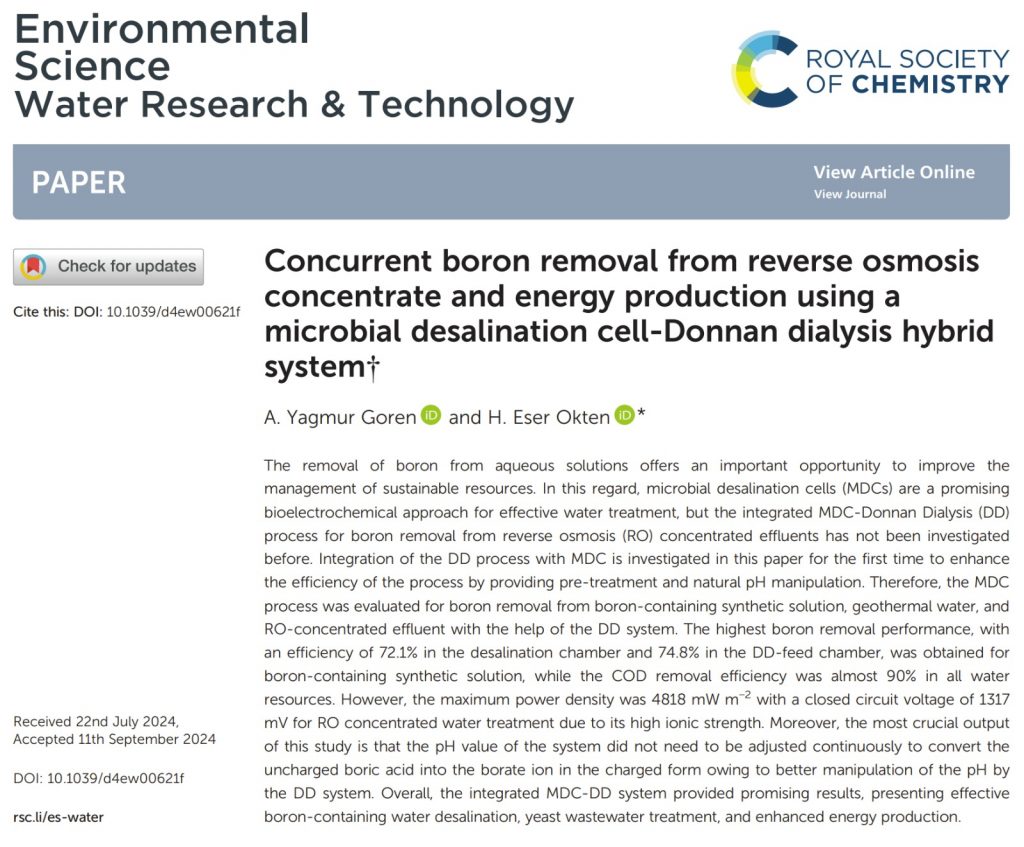
Concurrent boron removal from reverse osmosis concentrate and energy production using a microbial desalination cell-Donnan dialysis hybrid system
Our faculty members, Assoc. Prof. Dr. Hatice Eser Ökten and Research Assistant Dr. A. Yagmur Goren Kara’s article titled “Concurrent boron removal from reverse osmosis concentrate and energy production using a microbial desalination cell-Donnan dialysis hybrid system”, has been published in the Environmental Science: Water Research & Technology journal.
This research introduces a breakthrough in sustainable technology: This hybrid system combines a microbial desalination cell with Donnan dialysis to remove boron from reverse osmosis concentrate and produce clean energy, all in one! Tackling pollution while producing power, this innovation paves the way for greener water treatment solutions.
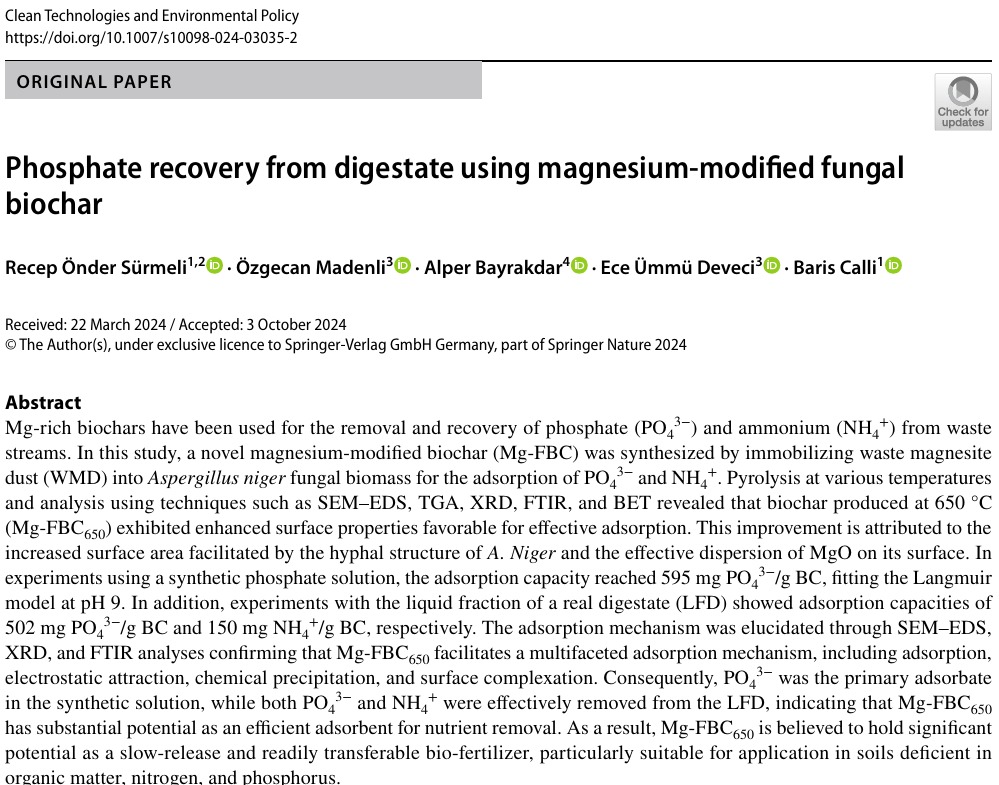
Comprehensive Phosphate Recovery from Digestate Using Magnesium-Modified Fungal Biochar
Mg-rich biochars have been used for the removal and recovery of phosphate (PO43−) and ammonium (NH4+) from waste streams. In this study, a novel magnesium-modified biochar (Mg-FBC) was synthesized by immobilizing waste magnesite dust (WMD) into Aspergillus niger fungal biomass for the adsorption of PO43− and NH4+. Pyrolysis at various temperatures and analysis using techniques such as SEM–EDS, TGA, XRD, FTIR, and BET revealed that biochar produced at 650 °C (Mg-FBC650) exhibited enhanced surface properties favorable for effective adsorption. This improvement is attributed to the increased surface area facilitated by the hyphal structure of A. Niger and the effective dispersion of MgO on its surface. In experiments using a synthetic phosphate solution, the adsorption capacity reached 595 mg PO43−/g BC, fitting the Langmuir model at pH 9. In addition, experiments with the liquid fraction of a real digestate (LFD) showed adsorption capacities of 502 mg PO43−/g BC and 150 mg NH4+/g BC, respectively. The adsorption mechanism was elucidated through SEM–EDS, XRD, and FTIR analyses confirming that Mg-FBC650 facilitates a multifaceted adsorption mechanism, including adsorption, electrostatic attraction, chemical precipitation, and surface complexation. Consequently, PO43− was the primary adsorbate in the synthetic solution, while both PO43− and NH4+ were effectively removed from the LFD, indicating that Mg-FBC650 has substantial potential as an efficient adsorbent for nutrient removal. As a result, Mg-FBC650 is believed to hold significant potential as a slow-release and readily transferable bio-fertilizer, particularly suitable for application in soils deficient in organic matter, nitrogen, and phosphorus.
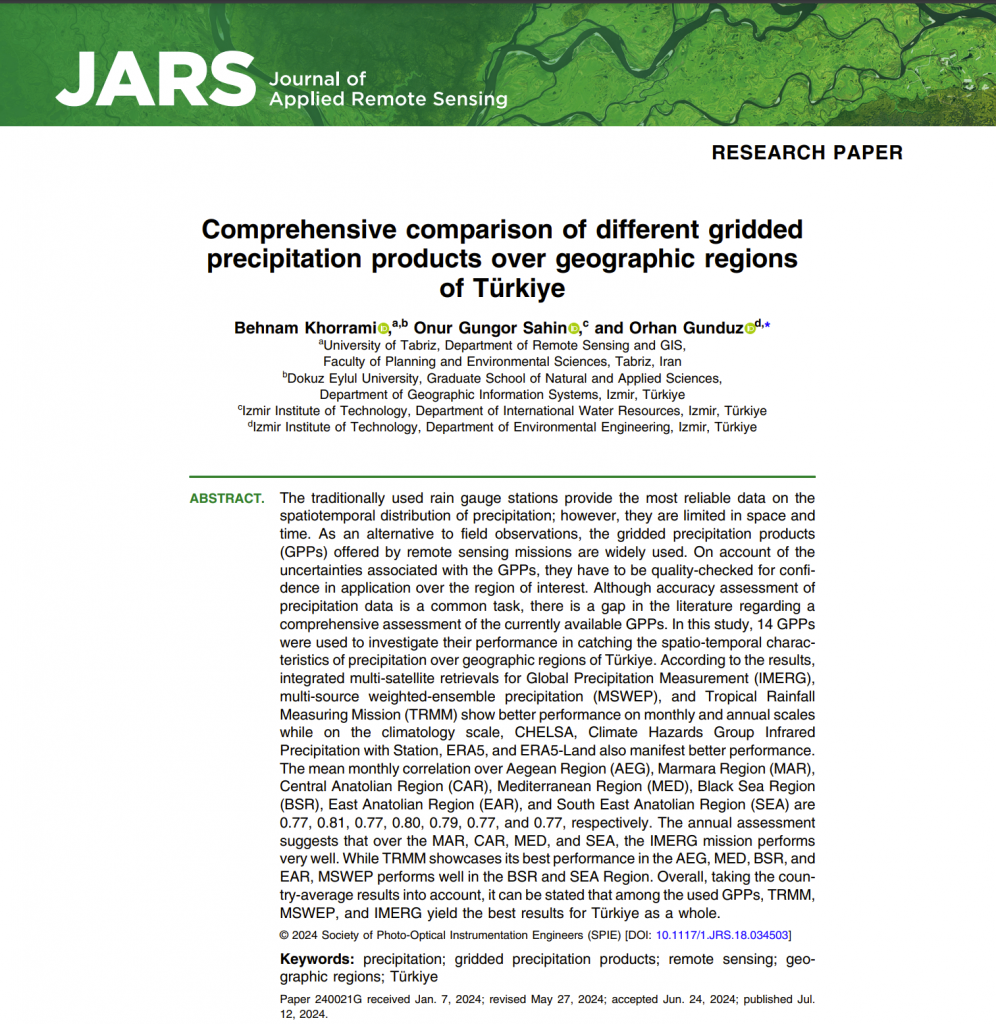
Comprehensive comparison of different gridded precipitation products over geographic regions of Türkiye
The traditionally used rain gauge stations provide the most reliable data on the spatiotemporal distribution of precipitation; however, they are limited in space and time. As an alternative to field observations, the gridded precipitation products (GPPs) offered by remote sensing missions are widely used. On account of the uncertainties associated with the GPPs, they have to be quality checked for confidence in application over the region of interest. Although accuracy assessment of precipitation data is a common task, there is a gap in the literature regarding a comprehensive assessment of the currently available GPPs. In this study, 14 GPPs were used to investigate their performance in catching the spatio-temporal characteristics of precipitation over geographic regions of Türkiye. According to the results, integrated multi-satellite retrievals for Global Precipitation Measurement (IMERG), multi-source weighted-ensemble precipitation (MSWEP), and Tropical Rainfall Measuring Mission (TRMM) show better performance on monthly and annual scales while on the climatology scale, CHELSA, Climate Hazards Group Infrared Precipitation with Station, ERA5, and ERA5-Land also manifest better performance.
The mean monthly correlation over Aegean Region (AEG), Marmara Region (MAR), Central Anatolian Region (CAR), Mediterranean Region (MED), Black Sea Region (BSR), East Anatolian Region (EAR), and South East Anatolian Region (SEA) are 0.77, 0.81, 0.77, 0.80, 0.79, 0.77, and 0.77, respectively. The annual assessment suggests that over the MAR, CAR, MED, and SEA, the IMERG mission performs very well. While TRMM showcases its best performance in the AEG, MED, BSR, and EAR, MSWEP performs well in the BSR and SEA Region. Overall, taking the country-average results into account, it can be stated that among the used GPPs, TRMM, MSWEP, and IMERG yield the best results for Türkiye as a whole
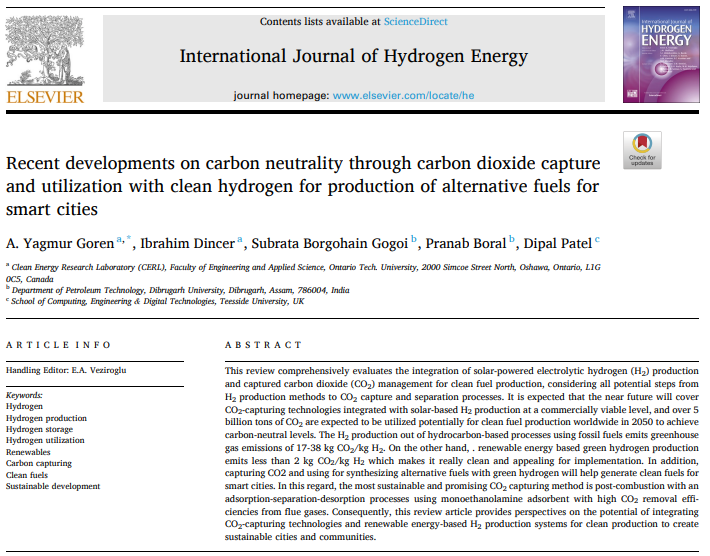
Recent Developments on Carbon Neutrality through Carbon Dioxide Capture and Utilization with Clean Hydrogen for Production of Alternative Fuels for Smart Cities
As global efforts to tackle climate change intensify, achieving carbon neutrality has become a vital objective for governments, industries, and communities worldwide. One of the most promising pathways to carbon neutrality is the integration of carbon dioxide capture and utilization technologies with clean hydrogen for the production of alternative fuels, particularly within the context of smart cities. Consequently, integrating carbon dioxide capture and utilization with clean hydrogen to produce alternative fuels represents a sustainable approach to achieving carbon neutrality and clean energy. Smart cities, with their commitment to sustainability and innovation, are at the forefront of this transition. By utilizing recent technological advancements and promoting collaborative efforts, we can create a cleaner, more sustainable future for urban environments worldwide.
Our department’s Research Assistant, Dr. A. Yagmur Gören Kara’s review paper on “Recent developments on carbon neutrality through carbon dioxide capture and utilization with clean hydrogen for production of alternative fuels for smart cities” with researchers from Ontario Tech University, Dibrugarh University, and Teesside University has been published in International Journal of Hydrogen Energy.
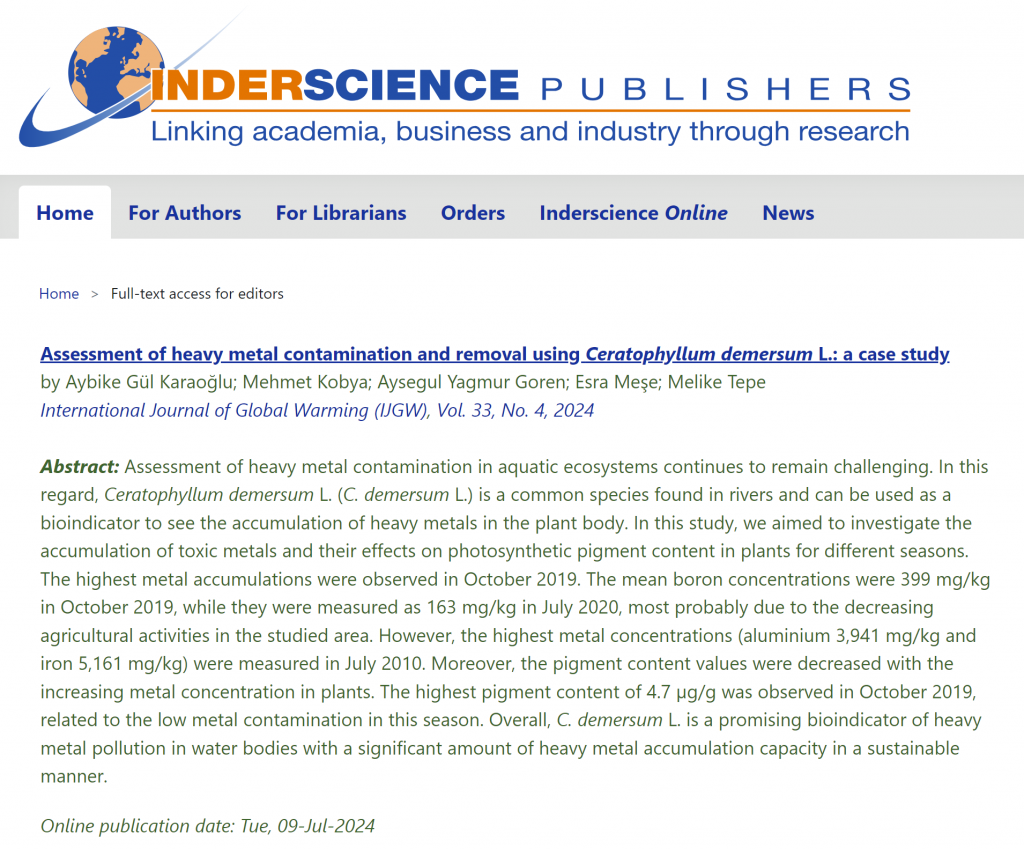
Assessment of Heavy Metal Contamination and Removal using Ceratophyllum demersum L.: A Case Study
The increasing levels of heavy metal contamination in soil present a significant environmental challenge, affecting agricultural productivity, ecosystem health, and human well-being. Traditional remediation methods often involve high costs and complex procedures, prompting the need for more sustainable and cost-effective solutions. One promising approach is the use of phytoremediation, where plants are employed to absorb, stabilize, and detoxify contaminants from the soil. Among the various plant species used for this purpose, Ceratophyllum demersum L. has shown considerable potential. The use of Ceratophyllum demersum L. for the remediation of heavy metals from soil represents a promising and sustainable approach to address environmental contamination. Its natural ability to absorb and stabilize heavy metals, coupled with its cost-effectiveness and environmental benefits, makes it an attractive option for large-scale implementation. However, further research and field trials are necessary to optimize its use and address the associated challenges, ensuring its efficiency in diverse environmental conditions. By harnessing the potential of this aquatic plant, we can take significant strides towards a cleaner and healthier environment.
Our department’s Research Assistant, Dr. A. Yagmur Gören Kara’s research paper on “Assessment of heavy metal contamination and removal using Ceratophyllum demersum L.: a case study” with researchers from Gebze Technical University and Polar Research Institute has been published in the International Journal of Global Warming.
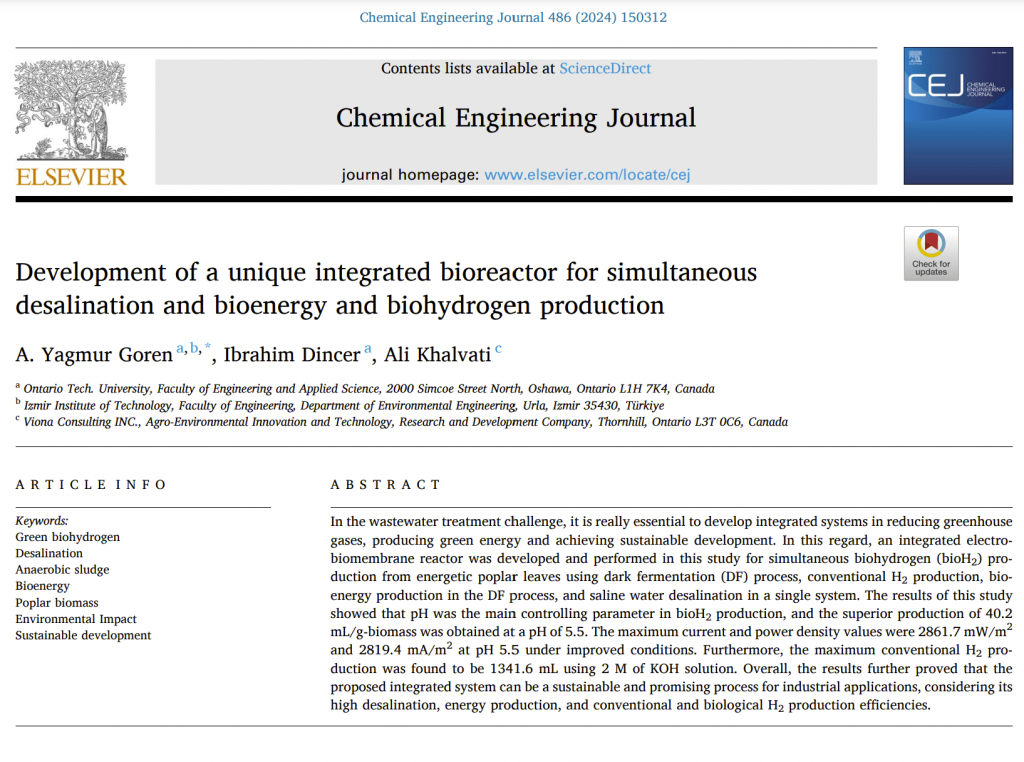
Development of a unique integrated bioreactor for simultaneous desalination and bioenergy and biohydrogen production
Due to increasing population and industrialization, the global demand for energy is rising. Consequently, attention has shifted towards exploring alternative energy sources, prompted by the detrimental effects of fossil fuels, their susceptibility to price fluctuations, and their adverse impacts on sustainable development. For instance, studies such as sustainable biodiesel production by utilizing wastes and algae are attracting considerable interest. Moreover, hydrogen (H2) has emerged as a pivotal environmentally friendly fuel option, owing to its remarkable energy density and an annual production volume of 55 million tons. However, the commercialization of these types of fuels is hindered by issues related to their transportation and storage; and the fact that the use of fossil fuels is still essential in most sectors and processes in the industry. In this context, biohydrogen (bioH2) has attracted more attention among biofuels due to many benefits including cost-effectiveness, ease of production, efficiency, and its status as an environmentally friendly energy source. Furthermore, organic materials and microorganisms present in wastes and wastewater can become a valuable source of sustainable and renewable energy.
Our department’s Research Assistant Dr. A. Yagmur Gören Kara’s research paper on the treatment of wastewater and hydrogen production using an integrated electro-biomembrane reactor developed with researchers from Ontario Tech University, has been published in the Chemical Engineering Journal.
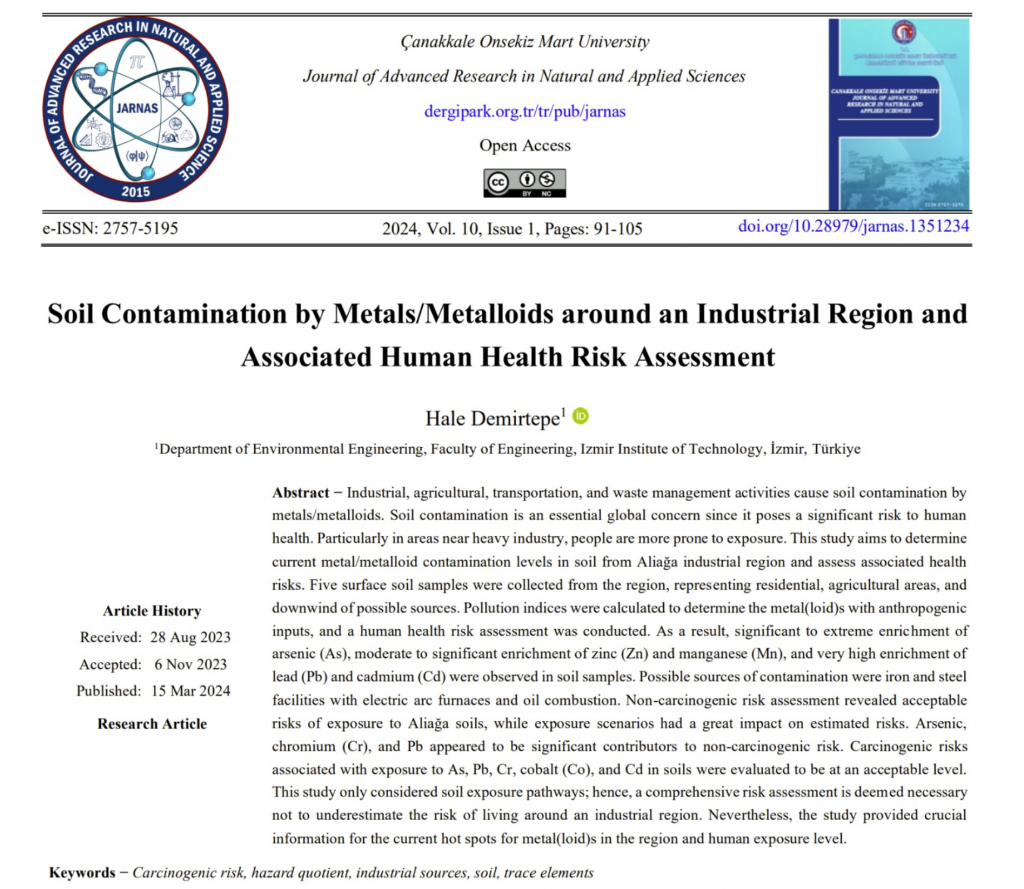
Soil contamination by Metals/Metalloids around an Industrial Region and Associated Human Health Risk Assessment
Our faculty member Dr. Hale Demirtepe’s article titled “Soil Contamination by Metals/Metalloids around an Industrial Region and Associated Human Health Risk Assessment” has been published in the “Journal of Advanced Research in Natural and Applied Sciences” by Çanakkale 18 Mart University.
Metals and metalloids are significant pollutants caused by industrial activities. Particularly in regions affected by such activities, soil pollution should be monitored, and the potential health risk associated with pollution for the local residents should be identified. In this valuable study conducted by Dr. Hale Demirtepe, soil metal and metalloid levels were investigated in Izmir Aliaga, which is one of the significant industrial regions in the area, and a health risk assessment was carried out. Although the health risk due to soil pollution is found to be at an acceptable level, a more comprehensive risk assessment is recommended for the people living in this region.
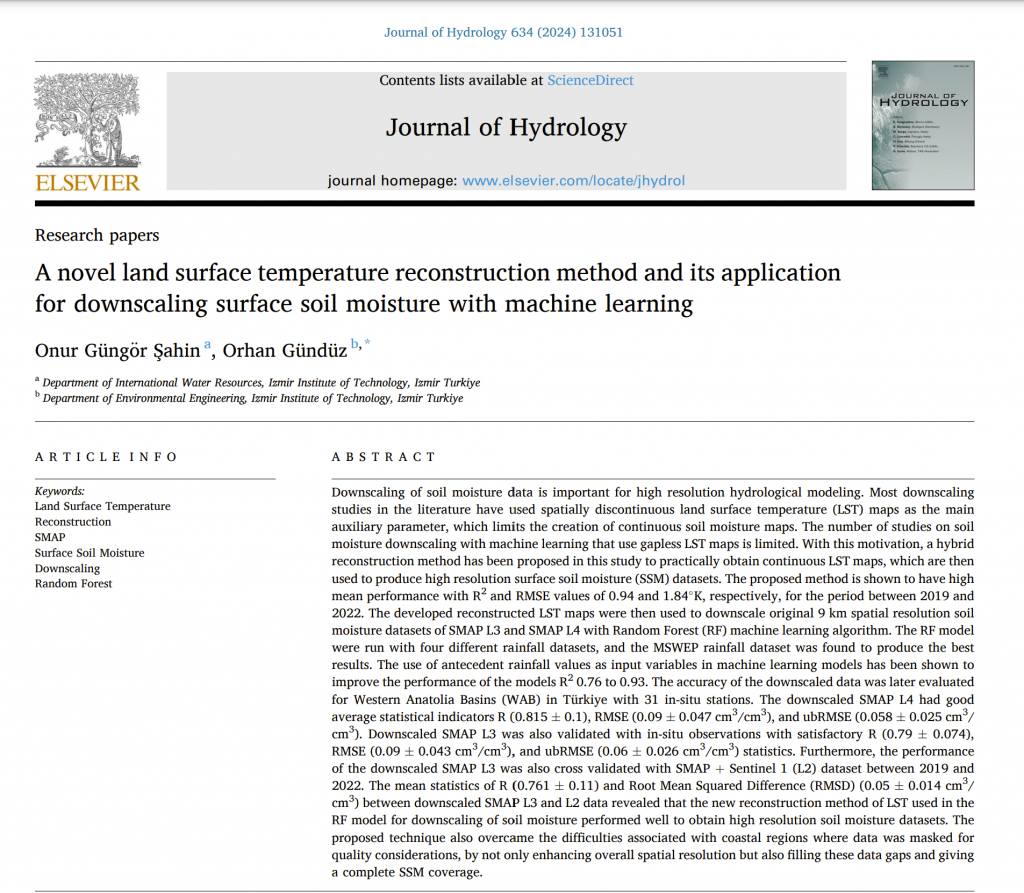
A novel land surface temperature reconstruction method and its application for downscaling surface soil moisture with machine learning
The research article titled “A novel land surface temperature reconstruction method and its application for downscaling surface soil moisture with machine learning”, prepared by our Department’s Faculty Member Prof. Dr. Orhan Gündüz and Doctoral Student Onur Güngör Şahin from the International Water Resources Department, has been published in the “Journal of Hydrology”.
The satellite observation of soil moisture in an area for hydrological, agricultural, etc. purposes in high resolution is an important issue. One of the common methods used for this objective is downscaling with machine learning. The land surface temperature (LST) is used as the main parameter in performing a more detailed surface analysis with the downscaling process. However, during the LST mapping, spatial and temporal gaps occur when there is cloud density in the sky. In this study, a practical and applicable method that allows different data sets to be used simultaneously has been proposed to eliminate these gaps and deficiencies. Then, high-resolution daily moisture maps for the Western Anatolia Basins were produced using this method.
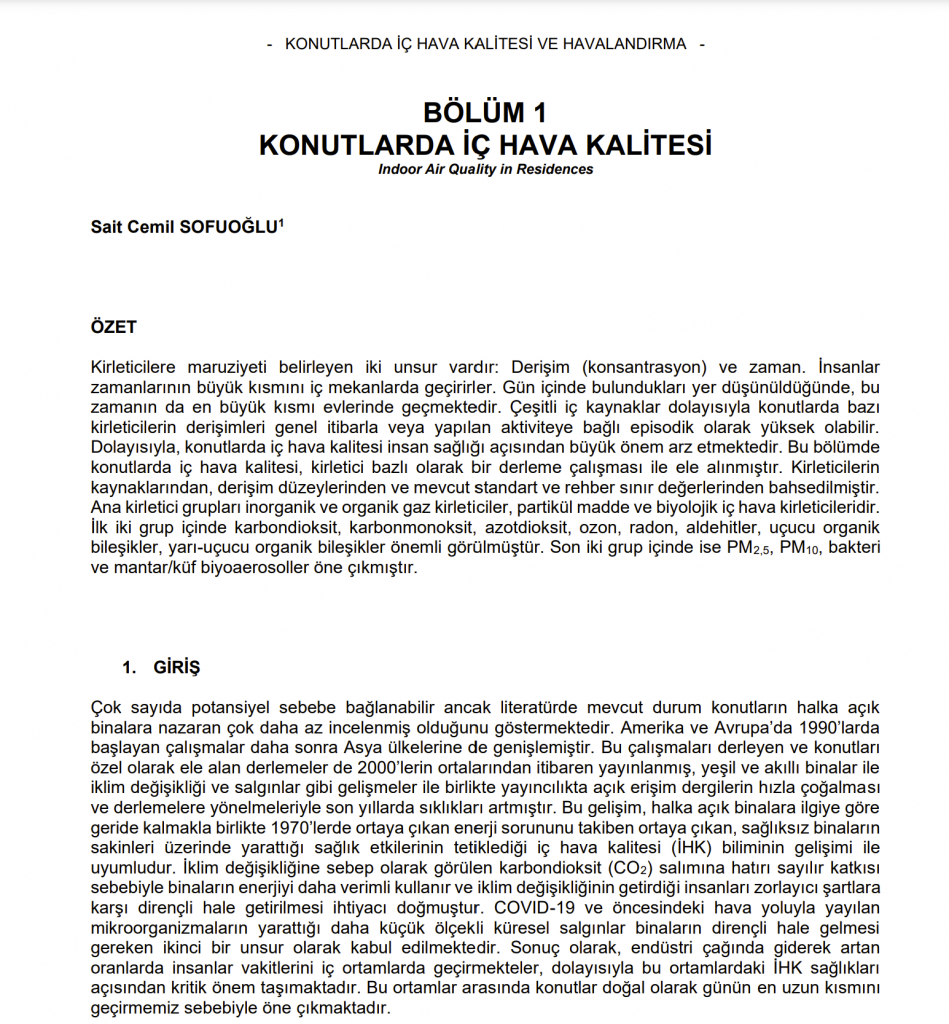
Indoor Air Quality in Residences
The exposure to pollutants depends on two factors: Concentration and time. People largely spend their time indoors. Considering the places they occupy throughout the day, the majority of this time is spent at home. Due to various indoor sources, concentrations of some pollutants in residences can be high either generally or episodically, depending on the activities performed. Therefore, indoor air quality in residences is of great importance for human health.
The first volume of the book “INDOOR AIR QUALITY IN RESIDENCES”, of which our Department Head Prof. Dr. Sait Cemil Sofuoğlu is one of the authors, has been published by the Mechanical Engineers Association.
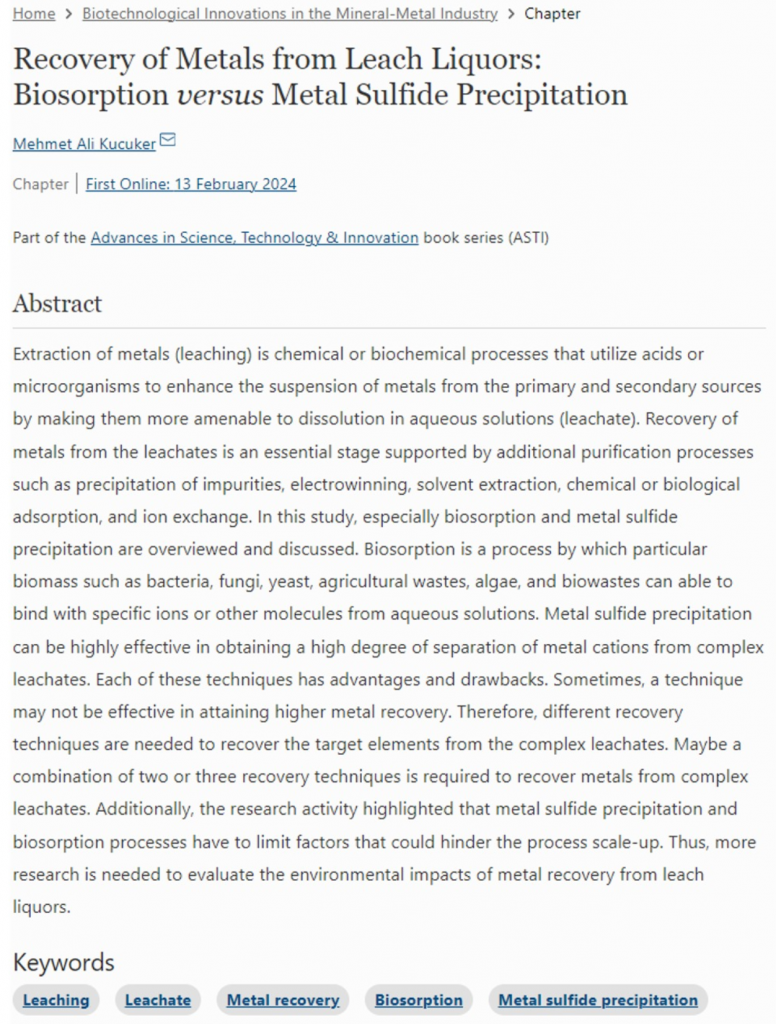
Recovery of Metals from Leach Liquors: Biosorption versus Metal Sulfide Precipitation
The book chapter titled “Recovery of Metals from Leach Liquors: Biosorption versus Metal Sulfide Precipitation” authored by our faculty member, Dr. Ing. Mehmet Ali Küçüker, has been published in the book “Biotechnological Innovations in the Mineral-Metal Industry” which is part of the “Advances in Science, Technology & Innovation” book series by Springer Publishing.
This study discusses the process of extracting metals from primary and secondary sources using leaching methods, which involve acids or microorganisms. After metal suspension is achieved, recovery from the resulting solutions is essential and often involves additional treatment processes. The study specifically overviews and discusses biosorption and metal sulfide precipitation. While each technique has its pros and cons, sometimes a combination of recovery methods is necessary for effective metal recovery. The study also highlights the need for more research on the environmental impact of these processes.

Renewable-based treatment solution of Reactive Blue 21 dye on fly ash as low-cos and sustainable adsorbent
The research article covering the study of R.A. Dr. A. Yagmur Gören Kara and researchers from Ontario Tech University related to newly developed electro-biomembrane reactor for simultaneous desalination of salt waters and green hydrogen production, has been published in the Process Safety and Environmental Protection Journal.
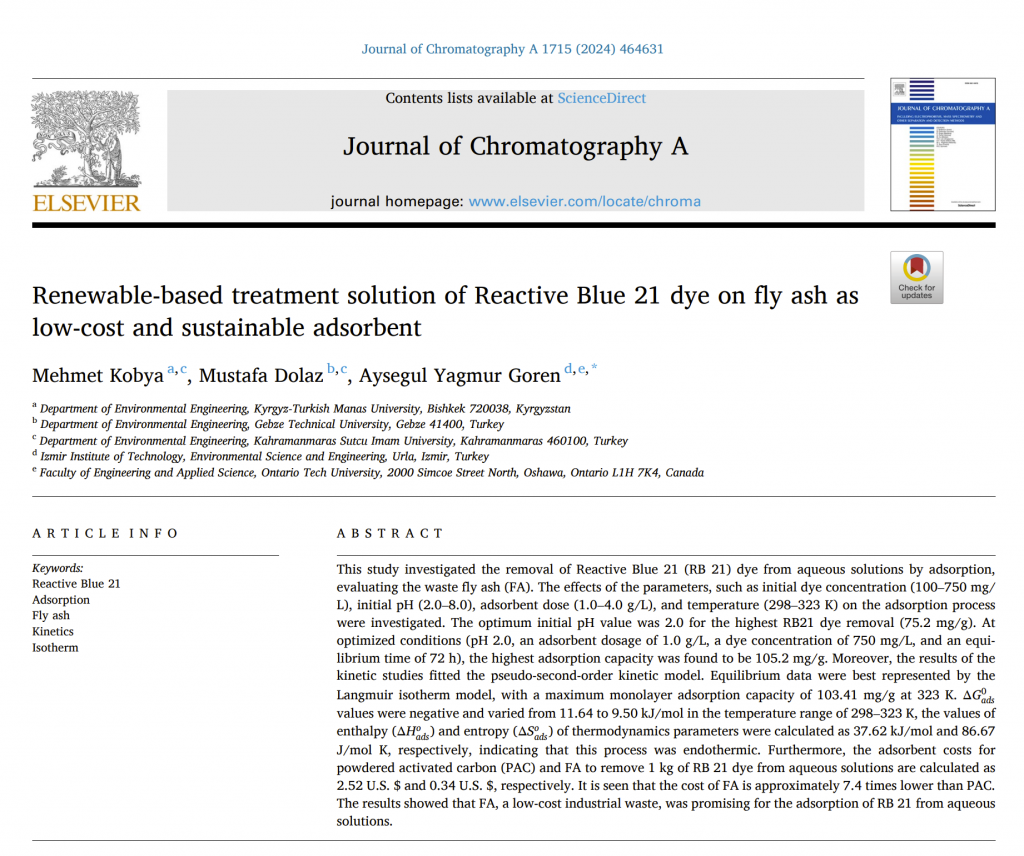
Renewable-based treatment solution of Reactive Blue 21 dye on fly ash as low-cos and sustainable adsorbent
The research article integrating the concepts of sustainable and low-cost treatment of textile wastewater and solid waste management, which is conducted by our Research Assistant Dr. A. Yagmur Gören Kara along with researchers from Gebze Technical University and Kahramanmaras Sutcu Imam University, has been published in “the Journal of Chromatography A”.
